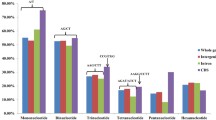Abstract
The potential of microsatellite sequences as genetic markers in hexaploid wheat (Triticum aestivum) was investigated with respect to their abundance, variability, chromosomal location and usefulness in related species. By screening a lambda phage library, the total number of (GA)n blocks was estimated to be 3.6 x 104 and the number of (GT)n blocks to be 2.3 x 104 per haploid wheat genome. This results in an average distance of approximately 270 kb between these two microsatellite types combined. Based on sequence analysis data from 70 isolated microsatellites, it was found that wheat microsatellites are relatively long containing up to 40 dinucleotide repeats. Of the tested primer pairs, 36% resulted in fragments with a size corresponding to the expected length of the sequenced microsatellite clone. The variability of 15 microsatellite markers was investigated on 18 wheat accessions. Significantly, more variation was detected with the microsatellite markers than with RFLP markers with, on average, 4.6 different alleles per microsatellite. The 15 PCR-amplified microsatellites were further localized on chromosome arms using cytogenetic stocks of Chinese Spring. Finally, the primers for the 15 wheat microsatellites were used for PCR amplification with rye (Secale cereale) and barley accessions (Hordeum vulgare, H. spontaneum). Amplified fragments were observed for ten primer pairs with barley DNA and for nine primer pairs with rye DNA as template. A microsatellite was found by dot blot analysis in the PCR products of barley and rye DNA for only one primer pair.
Similar content being viewed by others
References
Chungwongse J, Martin GB, Tanksley SD (1993) Pre-germination genotypic screening using PCR amplification of half seeds. Theor Appl Genet 86:694–698
Condit R, Hubbell SP (1991) Abundance and DNA sequence of two-base repeat regions in tropical tree genomes. Genome 34:66–71
Copeland NG, Jenkins NA, Gilbert DJ, Eppig JT, Maltais LJ, Miller JC, Dietrich WF, Weaver A, Lincoln SE, Steen RG, Stein LD, Nadeau JH, Lander ES (1993) A genetic linkage map of the mouse: current applications and future prospects. Science 262:57–66
Feinberg AP, Vogelstein B (1983) A technique for radiolabelling DNA restriction fragments to high specific activity. Anal Biochem 132:6–13
Flavell RB, Bennett MD, Seal AG, Hutchinson J (1987) Chromosome structure and organisation. In: Lupton FGH (ed) Wheat breeding. Its scientific base. Chapman and Hall, London New York, pp 222–268
Gale MD, Sharp PJ (1988) Genetic markers in wheat. Proc 7th Int Wheat Genet Symp, Cambridge, pp 469–475
Botstein D, White RL, Skolnick M, Davis RW (1980) Construction of a genetic linkage map in man using restriction fragment length polymorphisms. Am J Hum Genet 32:314–331
Akkaya MS, Bhagwat AA, Cregan PB (1992) Length polymorphisms of simple sequence repeat DNA in soybean. Genetics 132:1131–1139
Anderson JA, Churchill GA, Autrique JE, Tanksley SD, Sorrells ME (1993) Optimizing parental selection for genetic linkage maps. Genome 36:181–186
Barendse W, Armitage SM, Kossarek LM, Shalom A, Kirkpatrick BW, Ryan AM, Clayton D, Li L, Neibergs HL, Zhang N, Grosse WM, Weiss J, Creighton P, McCarthy F, Ron M, Teale AJ, Fries R, McGraw RA, Moore SS, Georges M, Soller M, Womack JE, Hetzel DJS (1994) A genetic linkage map of the bovine genome. Nat Genet 6:227–235
Bell CJ, Ecker JR (1994) Assignment of 30 microsatellite loci to the linkage map of Arabidopsis. Genomics 19:137–144
Bishop MD, Kappes SM, Keele JW, Stone RT, Sunden SLF, Hawkins GA, Toldo SS, Fries R, Grosz MD, Yoo J, Beattie CW (1994) A genetic linkage map for cattle. Genetics 136:619–639
Lagercrantz U, Ellegren H, Andersson L (1993) The abundance of various polymorphic microsatellite motifs differs between plants and vertebrates. Nucleic Acids Res 21:1111–1115
Litt M, Luty JA (1989) A hypervariable microsatellite revealed by in vitro amplification of a dinucleotide repeat within the cardiac muscle actin gene. Am J Hum Genet 44:397
Liu YG, Mori N, Tsunewaki K (1990) Restriction fragment length polymorphism (RFLP) analysis in wheat. 1. Genomic DNA library construction and RFLP analysis in common wheat. Jpn J Genet 65:367–380
Moore SS, Sargeant LL, King TJ, Mattick JS, Georges M, Hetzel JS (1991) The conservation of dinucleotide microsatellites among mammalian genomes allows the use of heterologous PCR primer pairs in closely related species. Genomics 10:654–660
Morgante M, Olivieri AM (1993) PCR-amplified microsatellites as markers in plant genetics. Plant J 3:175–182
Rafalski JA, Tingey SV (1993) Genetic diagnostics in plant breeding: RAPDs, microsatellites and machines. Trends Genet 9:275–280
Rohrer GA, Alexander LJ, Keele JW, Smith TP, Beattie CW (1994) A microsatellite linkage map of the porcine genome. Genetics 136:231–245
Sambrook J, Fritsch EF, Maniatis T (1989) Molecular cloning: a laboratory manual, 2nd edn. Cold Spring Harbor Laboratory Press, Cold Spring Harbor, New York
Schlötterer C, Amos B, Tautz D (1991) Conservation of polymorphic simple sequence loci in cetacean species. Nature 354:63–65
Senior ML, Henn M (1993) Mapping maize microsatellites and polymerase chain reaction confirmation of the targeted repeats using a CT primer. Genome 36:884–889
Tautz D, Renz M (1984) Simple sequences are ubiquitious repetitive components of eukaryotic genomes. Nucleic Acids Res 12:4127–4137
Tautz D, Trick M, Dover GA (1986) Cryptic simplicity in DNA is a major source of genetic variation. Nature 322:652–656
Weber JL, May PE (1989) Abundant class of human DNA polymorphisms which can be typed using the polymerase chain reaction. Am J Hum Genet 44:388–396
Weissenbach J, Gyapay G, Dib C, Vignal A, Morissette J, Millasseau P, Vaysseix G, Lathrop M (1992) A second-generation linkage map of the human genome. Nature 359:794–801
Wu K-S, Tanksley SD (1993) Abundance, polymorphism and genetic mapping of microsatellites in rice. Mol Gen Genet 241:225–235
Author information
Authors and Affiliations
Additional information
Communicated by R. G. Herrmann
Rights and permissions
About this article
Cite this article
Röder, M.S., Plaschke, J., König, S.U. et al. Abundance, variability and chromosomal location of microsatellites in wheat. Molec. Gen. Genet. 246, 327–333 (1995). https://doi.org/10.1007/BF00288605
Received:
Accepted:
Issue Date:
DOI: https://doi.org/10.1007/BF00288605



